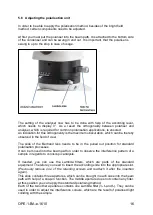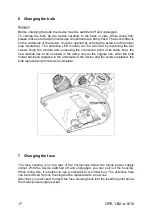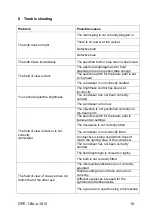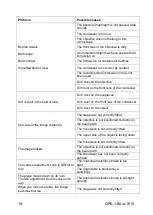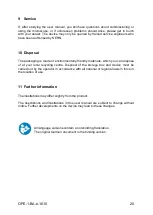
13
OPE-1-BA-e-1610
1. Bring the 10x objective into beam path.
2. Assure, that one eyepiece with scale is attached to (one of) the tube
connector(s).
3. Locate an appropriate specimen slide onto the table.
This slide should preferably be equipped with a micro reticule.
It would be also possible to use an object which includes plenty of single dots and for which
one of those dots has such a size, so that it aligns with the centre cross point of the scale,
visible inside of the eyepiece(s).
4. Locate the specimen slide to that point, that, when observing through the
eyepiece(s), the centre of the reticule is on the centre of the eyepiece scale.
5. Assure, that the fixing screw of the table is loosened, in order to be able to
revolve the table.
If the table is not or heavy to revolve, even though the fixing screw is loosened, this serves as
an evidence for a significant decentration of the table.
6. If the table is perfectly centre-adjusted, you will note that, during a complete
rotation of the table, both centres stay always aligned to each other.
In this case, the procedure would be finished at that point.
7. If the table is not centre-adjusted, you will note that the centre of the reticule
moves, directly after the beginning of the rotation of the table, away from the
centre of the eyepiece scale. And it matches again only after the complete
rotation.
8. Estimate the centre of the circular motion, which the reticule is doing, and
move the specimen slide, so that the centre of the reticule matches this
estimated centre.
9. Operate the centring screws, so that the centre of the reticule and the centre
of the eyepiece scale are aligning to each other again.
10. Repeat steps 6 - 9.
Содержание OPE 118
Страница 2: ......
Страница 7: ...OPE 1 BA e 1610 6 2 Nomenclature...
Страница 9: ...OPE 1 BA e 1610 8...

















